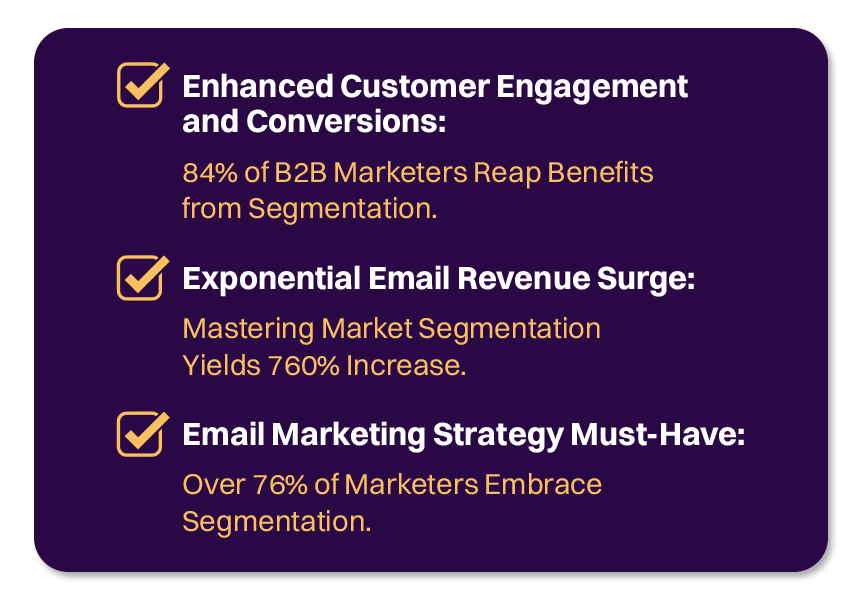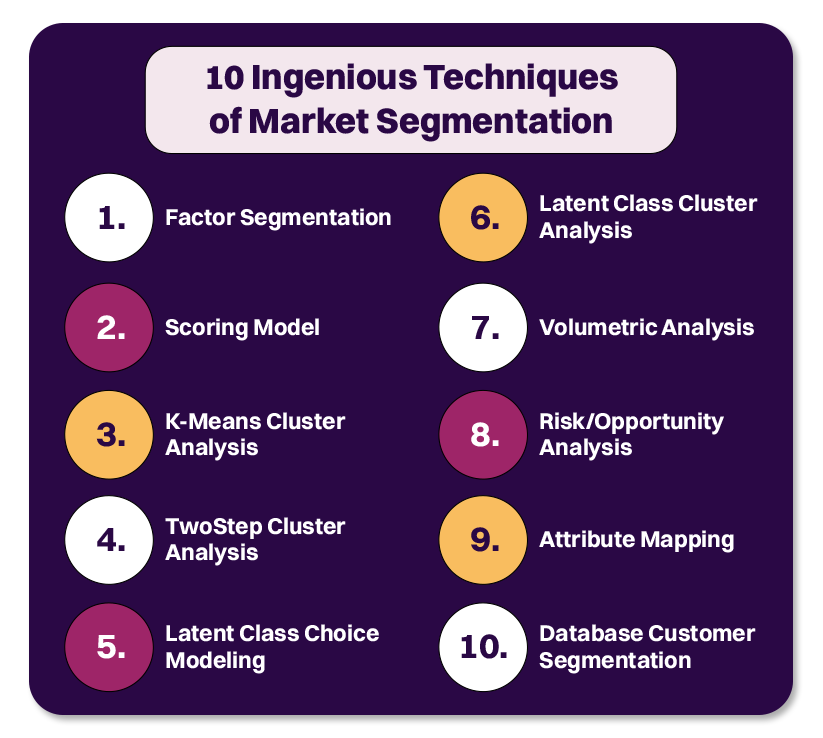
10 Ingenious Techniques of Market Segmentation for B2B Success
We all know this – personalized B2B marketing is the key to success in the current market, driven by fierce competition. And when we say personalization, another game-changing element instantly comes to mind – market segmentation.
Think of it as the ultimate strategy for breaking down barriers and connecting with your audience personally. Here’s how:
- Understanding Shared Characteristics: Imagine your audience as a diverse landscape. Market segmentation techniques transform this landscape into distinct territories. You'll understand what makes each territory unique, and that's your golden ticket.
- Tailoring Your Efforts: It's like having a conversation that resonates deeply. Market segmentation helps you tailor your marketing efforts to suit each territory. You're not just talking – you're speaking their language.
- Delivering Targeted Messages: Think of it as being a mind reader. Market segmentation gives you the insights you need to deliver messages that hit the bullseye. You're not just sending emails – you're sending messages that matter.
The proof is in the numbers:

These numbers sing a familiar song – the song of success through market segmentation.
To help you conquer this strategy, our experts have curated 10 ingenious methods tailored for B2B businesses like yours.
Each technique is designed to:
- Uncover hidden insights
- Guide your strategic decisions
- Open doors to new growth opportunities
So, brace yourself for the journey ahead. Here's our comprehensive list – your roadmap to mastering market segmentation:
10 Ingenious Techniques of Market Segmentation

Whether you're a B2B marketing veteran or stepping into a new business realm, this guide is your map to conquer market segmentation. Get ready to wield powerful techniques to transform your strategy and elevate your game.
1. Factor Segmentation
Factor Segmentation helps you find like-minded customers by revealing underlying factors and grouping them into tribes. You can then analyze connections between tribes to understand how different groups relate to each other.
Illustration:
Suppose you run a software company and use Factor Segmentation to create two tribes within your target market by customizing your CRM data.
Here are the underlying factors: Ease of use, integration capabilities, cost, support, and scalability.
| Findings | |
| Tribe A | Values cost-effectiveness and scalability |
| Tribe B | Prioritizes integration and support |
2. Scoring Model
The Scoring Model is like your sorting hat – but for data. Let’s say you’re running a data-driven show and want to group your respondents based on specific scores.
Here, the Scoring Model can serve as a magical formula that sorts respondents into different segments – by giving them certain scores.
But how does it work? Think of it as a two-step dance.
- Discriminant Analysis. It's like a spotlight that shines on the most important questions or variables that make each segment unique. It's like figuring out the key ingredients that define each segment.
- Regression Analysis. This step dives deeper. It's like understanding how different variables sync together. It helps you see how changes in one variable influence the outcome – in this case, the segment a respondent belongs to.
Illustration:
Let’s assume you utilize the Scoring Model for lead classification in your software business:
Here are your customer segments: Small businesses, mid-sized enterprises, and large corporations.
| Findings | |
| Discriminant Analysis | Identifies these lead influencers: business size, revenue, and industry. |
| Regression Analysis |
Curates a weighted formula and gives you the following results:
|
3. K-Means Cluster Analysis
Need to group your customers based on similarities? K-Means Cluster Analysis is your data magician. It automatically groups customers with similar characteristics based on their traits.
Illustration:
Let’s say your B2B retail company seeks deeper customer understanding. Here’s the data you have: revenue and budget. Next, you deploy K-Means Cluster Analysis and identify the following:
| Findings | |
| Tribe A | Hefty revenue, high-value buyers with substantial budgets. |
| Tribe B | Average revenue, moderate-value purchasers with standard budgets. |
| Tribe C | Limited revenue, conservative buyers with constrained budgets. |
| Outcomes: Tailored marketing for each tribe | |
| Tribe A | High-end promotions. |
| Tribe B | Middle-ground campaigns. |
| Tribe C | Budget-friendly offers. |
4. TwoStep Cluster Analysis
Let’s say you've got this massive dataset and are curious about the stories it holds. TwoStep Cluster Analysis is your data detective. It's designed to tackle big datasets head-on and unveil their secrets. Also, it seamlessly handles continuous and categorical variables alike.
And that's not all – this versatile toolbox can handle everything from annual revenue figures to gender and industry type. This technique is all about embracing variety in your data.
It even uses a clever algorithm to find the sweet spot – the number of clusters that best fits your data.
Illustration:
Let’s say your firm is a leading market research agency with vast client data. Your data includes size, revenue, and satisfaction. You use TwoStep Cluster Analysis.
| Findings: Three clusters | |
| Tech giants | High revenue, industry dominance. |
| Medium manufacturing champs | Diverse revenue stories. |
| Small retail players | Niche strength |
| Outcomes: Tailored strategies | |
| Tech giants | High revenue marketing |
| Retail heroes | Targeted solutions. |
| Manufacturing champs | Varied support |
5. Latent Class Choice Modeling
Picture this: You've got this treasure trove of product benefits. Now, you want to know which ones your customers adore and which ones they can do without. Latent Class Choice helps you understand what your customers truly desire.
- You ask them to pick their favorites and their not-so-favorites from a list of product benefits.
- You also ask them to rate how much these benefits influence their buying decision.
Latent Class Choice Modeling takes these responses and groups customers with similar preferences together, revealing distinct segments.
Illustration:
Let’s assume you are the head of a B2B project management software company. You utilize Latent Class Choice Modeling for customer insights. Customers select preferred/least preferred benefits.
| Findings: Two distinct segments | |
| Segment A | Values collaboration and reporting. |
| Segment B | Prioritizes task tracking and budget management. |
| Benefits: Craft offerings aligned with desires | |
| Segment A | Advanced collaboration and reporting. |
| Segment B | Premium task management and budgeting. |
6. Latent Class Cluster Analysis
Ever wondered how to slice through your data and find hidden patterns like a pro? Well, that's where Latent Class Cluster Analysis swoops in. It finds the right data pieces, assembles them, and unveils the bigger picture.
So, what's the big deal? It's about grouping similar things together and revealing the unique patterns – like common attitudes, needs, and behaviors – hidden in the chaos.
And here's the cool part: it's not just about grouping data. It also determines the following:
- The optimal number of groups (clusters)
- How well the data fits into those groups
Do you know what else is impressive? Latent Class Cluster Analysis isn't picky about data types. It seamlessly adapts to different types of questions and scales in your surveys:
- Yes/No responses? No problem.
- Multiple-choice questions? Piece of cake.
- Rating scales in all shapes and sizes? Easy.
- Even volumetric data, like sales volumes or warehouse capacities? Handles like a pro.
And the best part? It can incorporate secondary variables like brand usage or demographics to create even richer insights.
Illustration:
Say you are the CEO of a tech company launching new software. Your team embraces Latent Class Cluster Analysis for market understanding. Your data includes buyer attitudes, buying, preferences, and demographics.
| Findings: Three segments | |
| Innovators | Crave novelty. |
| Budget-conscious | Prioritize practicality. |
| Reliability seekers | Stick to established brands. |
| Benefits: Customized marketing akin to tailored suits | |
| Innovators | Cutting-edge features. |
| Budget-savvy | Value proposition. |
| Reliability seekers | Brand history assurance |
7. Volumetric Analysis
Volumetric Analysis is like your market crystal ball. It's all about predicting how much of the market you can capture and where you stand among the competition.
How does it work? So, here's the game plan:
- You gather a bunch of data from consumers – stuff like how often they buy, how much they buy, and what they're buying.
- You use this data to determine the potential volume within your product's category.
In this case, you're not just throwing numbers around randomly. But you're considering things like:
- The frequency of consumers making purchases
- The number of items they buy
- How much they're willing to pay
The magic happens when you extrapolate these numbers to understand how your product could perform in the real world. You're turning data into insights!
And guess what? This technique is a superhero when you're dealing with limited or unreliable sales data. It's like a light in the darkness, especially for new categories or niche markets.
Illustration:
Suppose you head an office furniture venture, introducing ergonomic chairs. Your firm uses Volumetric Analysis to gauge market interest. The collected data involves chair purchase frequency, quantity, and budget.
| Findings |
|
| Outcomes |
|
8. Risk/Opportunity Analysis
Picture this: You're trying to understand the twists and turns your product or service attributes can take. Risk Analysis is your roadmap in this voyage. It's all about weighing each attribute's potential risks and rewards on your customers' decision-making.
How does it work? Well, you're like a detective trying to determine the impact of each attribute on whether customers say "Yes" or "No" to your offering.
In this journey, you've got two types of travelers:
- Risk Drivers: These are like your anchor points. You watch them like a hawk because they're tied to how customers see you. They're like the foundation of your customer's satisfaction and perception.
- Opportunity Drivers: These are like hidden treasures waiting to be uncovered. They're areas that hold growth potential. Think of them as secret passages to make your offering even more enticing.
Collecting data for Risk Analysis? You just chat with your customers, like old friends catching up. Surveys and feedback mechanisms are your tools. You ask them to rate how critical different attributes are.
Plus, you dig a bit deeper and ask how changes in those attributes would impact their decision to buy.
Illustration:
Let’s assume you lead a project management software company. You employ Risk/Opportunity Analysis for attribute insights. Your customer insights reveal impacts on buying interest.
| Findings |
|
| Benefits: Strategic resource allocation |
|
9. Attribute Mapping
Imagine this: You're in a game of uncovering attributes that can make or break your brand. Attribute Mapping is your trusty sidekick in this quest. It helps you spot those attributes that hold immense importance and how well you're rocking them.
So, what's the big deal? Well, it's all about categorizing these attributes into different buckets:
- High Importance and Performance: They're like the crown jewels of your business. They're super important to your customers, and you're acing them.
Think of it as customers loving what you're doing and you delivering like a pro. These attributes are the reason your customers leave with smiles.
- High Importance and Low/Average Performance: These hidden gems are waiting to be polished. They're super important to your customers, but you're not quite there regarding delivery. This is your chance to step up and shine brighter.
Working on these attributes can elevate your brand and make your customers even happier.
Creating an Attribute Map? Simply gather data straight from the horse's mouth – your customers – through surveys or other feedback methods.
Illustration:
Say you are the director of a cloud software outsourcing company. Your firm utilizes Attribute Mapping to decode customer desires, and you get a snapshot of brand performance as per customer views.
| Findings |
|
| Benefits: Strategic direction |
|
10. Database Customer Segmentation
Imagine having multiple customer databases that don't communicate with each other. With Database Customer Segmentation, you can link and blend these databases to create a more powerful data symphony. You can group customers based on their attitudes, preferences, and shopping habits to gain deeper insights into their behavior.
Database Customer Segmentation techniques allow you to customize the solution for each database.
Once you know what makes these segments unique, you can whip up some seriously cool stuff:
- Craft laser-focused marketing strategies
- Cook up personalized messages that hit the right spot
- Serve up products and services that resonate with each group
Illustration:
Let’s say your SaaS company owns separate databases with info on what your customers are up to. You opt to optimize industry focus with Database Customer Segmentation. You unite separate databases for insights.
| Findings |
|
| Benefits: Tailored actions based on insights |
|
Wrapping It Up
We’re confident our ten market segmentation techniques will definitely enable you to create those much-desired and result-oriented custom B2B campaigns. However, if you’re more ambitious and aim to take your personalization strategies up a notch, you can partner with Revnew.
As a leading provider of innovative B2B lead generation solutions, we leverage data-driven frameworks and advanced analytics to help your business thrive. So get a strategic call now to explore how our cutting-edge solutions can revolutionize your B2B marketing strategy.
For further reading: Check out how Revnew helped Pointful Education set up 80 appointments within four months!




